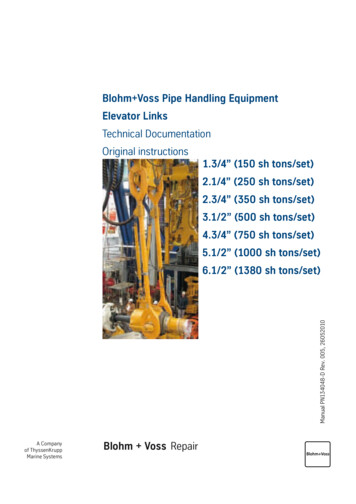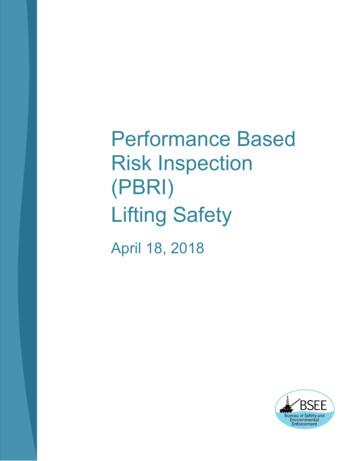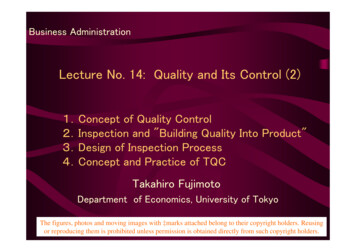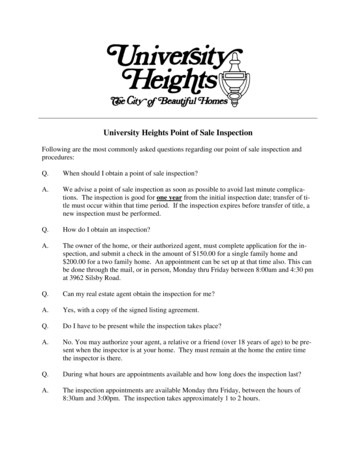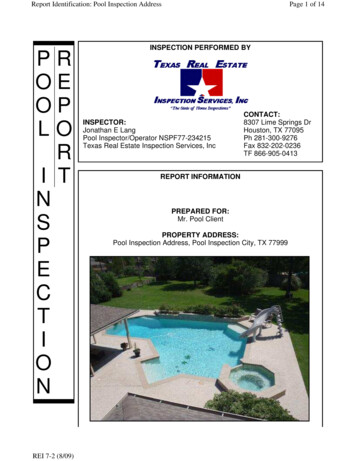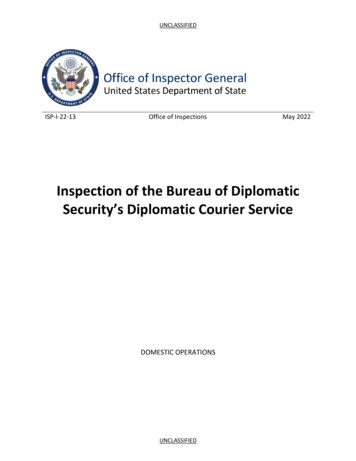
Transcription
UNCLASSIFIEDISP-I-22-13Office of InspectionsMay 2022Inspection of the Bureau of DiplomaticSecurity’s Diplomatic Courier ServiceDOMESTIC OPERATIONSUNCLASSIFIED
UNCLASSIFIEDMay 2022OFFICE OF INSPECTIONSDOMESTIC OPERATIONSInspection of the Bureau of Diplomatic Security’sDiplomatic Courier ServiceISP-I-22-13What OIG InspectedOIG inspected the operations of the DiplomaticCourier Service in the Bureau of DiplomaticSecurity.What OIG RecommendsOIG made 4 recommendations: 3 to the Bureau ofDiplomatic Security and 1 to the Bureau ofAdministration.In its comments on the draft report, theDepartment concurred with 3 recommendationsand neither agreed nor disagreed with 1recommendation. OIG considers all 4recommendations resolved. The Department’sresponse to each recommendation, and OIG’sreply, can be found in the Recommendationssection of this report. The Department’s formalresponse is reprinted in its entirety in Appendix B.What OIG Found The Diplomatic Courier Service’s Director andDeputy Director generally communicated well withstaff and modeled Department of State leadershipprinciples. There was a perception among some DiplomaticCourier Service staff, which had not beenaddressed, that favoritism was a factor indetermining assignments. Department guidance on reporting securityincidents involving classified pouches was unclearand sometimes contradictory, resulting ininconsistent reporting. Information systems security was not fullyintegrated into the Classified Pouch ModernizationEffort, and the Diplomatic Courier Service did notmaintain modernization project documentation ina Department-owned location. Spotlight on Success: The Bangkok RegionalDiplomatic Courier Division created a COVID-19Status Guide that increased efficiency in planningdiplomatic courier missions by consolidatingneeded information on travel requirements.UNCLASSIFIED
UNCLASSIFIEDCONTENTSCONTEXT . 1EXECUTIVE DIRECTION . 2IMPACT OF COVID-19 PANDEMIC ON OPERATIONS. 5SECURITY OPERATIONS . 6INFORMATION MANAGEMENT . 8RESOURCE MANAGEMENT . 10RECOMMENDATIONS. 11PRINCIPAL OFFICIALS . 13APPENDIX A: OBJECTIVES, SCOPE, AND METHODOLOGY . 14APPENDIX B: MANAGEMENT RESPONSE . 15ABBREVIATIONS . 17OIG INSPECTION TEAM MEMBERS . 18UNCLASSIFIED
UNCLASSIFIEDCONTEXTThe Bureau of Diplomatic Security, Countermeasures Directorate’s Diplomatic Courier Service(DS/C/DC) ensures secure delivery of classified and sensitive material between the Departmentof State (Department) and U.S. diplomatic missions worldwide. A diplomatic courier’s primaryduty is to ensure the inviolability of classified pouches and their unbroken chain of custodywhile crossing international borders or at any time the courier is in control of diplomaticmaterial. DS/C/DC supports more than 30 Department entities and other Federal agenciesaround the world and the Secretary of State’s global travel. Established in 1918 to improve mailand message delivery during World War I, DS/C/DC uses various methods of conveyance,including by road, sea, and air. Annually, it is responsible for delivering more than 5 millionpounds of classified and sensitive material across international borders in accordance withArticle 27 of the Vienna Conventions on Diplomatic and Consular Relations.The DS/C/DC organization, as shown in Figure 1, consists of a Headquarters office and theWashington Regional Diplomatic Courier Division, both located in the Washington, D.C. area;Regional Courier Divisions in Frankfurt, Germany; Miami, Florida; and Bangkok, Thailand; andCourier Hub Offices sited in Abidjan, Côte d’Ivoire; Dakar, Senegal; Manama, Bahrain; Nairobi,Kenya; Pretoria, South Africa; Seoul, South Korea; and Sao Paulo, Brazil.At the time of the inspection, DS/C/DC had 104 authorized U.S. direct-hire positions, 22 eligiblefamily members, and 33 locally employed staff. The diplomatic courier profession is a specialistcareer track in the Foreign Service. Of the 104 U.S. direct-hire positions, 2 were Senior ForeignService, 5 were FS-01, and 9 were FS-02.1 DS/C/DC also coordinates the work of nonprofessional couriers.21The Foreign Service pay scale for non-Senior Foreign Service employees comprises nine pay grades, with FS-01being the highest.2Non-professional couriers are U.S. Government employees who possess a Top Secret clearance and are providedwith official documentation to transport diplomatic pouches in emergencies or when a diplomatic courier cannotprovide the required service.ISP-I-22-131UNCLASSIFIED
UNCLASSIFIEDFigure 1: DS/C/DC Organizational ChartSource: OIG generated from information obtained from DS/C/DC.OIG evaluated the office’s executive direction, impact of the COVID-19 pandemic on operations,security operations, resource management, and information management operationsconsistent with Section 209 of the Foreign Service Act of 1980.3EXECUTIVE DIRECTIONOIG assessed DS/C/DC's leadership based on interviews that included comments onits leadership team, a review of OIG questionnaires completed by DS/C/DC staff and otherdocuments, and observation of activities during on-site inspection work.DS/C/DC's leadership consisted of a Director and Deputy Director. The Director who ledDS/C/DC at the beginning of the inspection retired from the Department in October 2021,3See Appendix A.ISP-I-22-132UNCLASSIFIED
UNCLASSIFIEDbefore the inspection’s conclusion. In November 2021, a new Director assumed DS/C/DCleadership. The new Director, a 22-year veteran of DS/C/DC, had most recently served as thehead of DS/C/DC’s Frankfurt Regional Diplomatic Courier Division. During his career, the newDirector had also previously served as the DS/C/DC Director from 2016 to 2019, as well as inother DS/C/DC positions both in Washington and overseas. The Deputy Director joined theFront Office in August 2019, and his previous DS/C/DC assignments included Manama, Bahrain;Washington, D.C.; Sao Paulo, Brazil; Frankfurt, Germany; and Bangkok, Thailand.OIG found that the recently retired DS/C/DC Director and the Deputy Director generallymodeled the Department's leadership and management principles set forth in 3 Foreign AffairsManual (FAM) 1214. The Director and the Deputy Director complemented each other, with theDirector focusing on strategic priorities and the Deputy Director managing daily operationalrequirements of DS/C/DC. The new Director said he expects this division of labor with theDeputy Director to continue.Leadership Communicated Effectively With EmployeesThe Director and Deputy Director effectively communicated with the DS/C/DC staff inaccordance with 3 FAM 1214 b(4). They established several methods of communicationswith the four regional divisions and seven hub offices. For example, the Director establishedmonthly leadership calls to the regional directors and the deputy regional directors to sharerelevant information. The Director supplemented this dialogue with weekly telephone calls toeach regional director to discuss important topics.The DS/C/DC Front Office also shared information with DS/C/DC staff through the distributionof Weekly Activity Reports posted on its intranet site, the distribution of Quarterly PerformanceReports, daily situation reports submitted by each Regional Division, and mass emails tocommunicate with all DS/C/DC staff, including discussions of leadership tenets. To obtainfeedback on DS/C/DC operations, the Director and Deputy Director encouraged diplomaticcouriers to visit them in their offices and to email them directly. The Director and DeputyDirector also obtained feedback by asking their customers for their perspectives on DS/C/DCoperations.Office Needed to Address Perceptions of Favoritism in Assignments ProcessSenior leaders raised with OIG concerns that there was a perception of favoritism in DS/C/DCwith respect to the assignments process. To determine assignments, diplomatic couriers bid onand expressed interest in open positions. DS/C/DC senior leaders then discussed who should beassigned to what position and made recommendations to a DS panel. That panel submittedfinal recommendations to the Bureau of Global Talent Management, which made finalassignments. However, while DS/C/DC senior leaders stated their recommendations werebased on diplomatic courier preferences along with mission needs, the factors for considerationwere not written and were not well-known to staff.ISP-I-22-133UNCLASSIFIED
UNCLASSIFIEDThrough interviews with DS/C/DC staff, OIG confirmed that there was a perception amongsome, but not all, diplomatic couriers that favoritism was a factor when DS/C/DC senior staffprepared post assignments of diplomatic couriers. Related to this perception was that favorableassignments could contribute to some couriers being able to better demonstrate theircompetency for promotion. Some staff noted rumors of favoritism while others said they hadbeen warned about favoritism, perpetuating the perception in the organization. OIG noted thatthe problem was exacerbated by the fact that DS/C/DC leadership had not addressed the issuedirectly with employees by transparently sharing the process for making assignments or bystating its commitment to making decisions on courier assignments free of favoritism.According to 3 FAM 1214b(1), (4), and (9), Department employees should model integrity, becognizant of the morale and attitude of employees, and encourage an atmosphere of opendialogue and trust. Senior leaders, including the Director and the Deputy Assistant Secretaryabove him, acknowledged that the perception of favoritism was a serious issue and one thatthey wanted to remediate even though they had not previously addressed it directly. Failing toaddress perceptions of favoritism can undermine employee confidence, morale, and trust in theorganization.Recommendation 1: The Bureau of Diplomatic Security should require Diplomatic CourierService leadership to develop and share its process for courier assignments with allemployees including the commitment that decisions will be made free of favoritism.(Action: DS)Mentoring First- and Second-Tour Diplomatic CouriersDS/C/DC does not have a formal mentoring program for its first- and second-tour diplomaticcouriers. DS/C/DC relied on informal mentoring programs at regional divisions and hubs inwhich experienced diplomatic couriers volunteered to guide and assist first- and second-tourdiplomatic couriers. In addition to one-on-one advice from an experienced diplomatic courier,the informal mentoring programs included being paired with an experienced diplomatic courierfor one or more trips to gain practical experience. Some diplomatic couriers told OIG that theybelieved the informal mentoring programs worked well, but others expressed a desire for amore formal mentoring program. Department guidance in 3 FAM 1214b(8) makes embracingmentoring and other means to develop talent a core precept of the Department’s leadershipand management principles.Given the wide range of views among the diplomatic couriers on informal mentoring, OIGbrought these issues to the new Director’s attention. In response, the Director stated heintended to quickly establish a service-wide mentor policy that detailed how every diplomaticcourier could be mentored in a consistent fashion during their first two tours. In addition tobeing paired with experienced diplomatic couriers on their first few trips, the Director said thatfirst- and second-tour diplomatic couriers would be assigned a mentor at their posts and haveregular meetings with supervisors to discuss issues of importance and promote learning.ISP-I-22-134UNCLASSIFIED
UNCLASSIFIEDIMPACT OF COVID-19 PANDEMIC ON OPERATIONSWith the onset of the COVID-19 pandemic, the Department significantly limited DS/C/DC’smissions to those that were critical to life safety or to U.S. national security. Many countriesimplemented quarantine requirements, airlines decreased the number of commercial aircraftavailable to carry cargo, and airlines started using aircraft with smaller cargo capacity,creating major challenges to DS/C/DC's normal delivery operations. In mid-March 2020,DS/C/DC stopped operating its normal missions, and any proposed diplomatic courier deliverieshad to be approved by the Deputy Assistant Secretary for Countermeasures and the ExecutiveDirector in Diplomatic Security. Each shipment required a special justification and a generaldescription of what the pouches contained.Quarantine requirements made it very difficult for diplomatic couriers to execute deliveries,especially in Asia, where countries had strict quarantine policies. For example, Thailandrequired a 2-week hotel quarantine after entry into the country. Additionally, due to entryrestrictions, diplomatic couriers took the next return flight after a delivery on trips that wouldtypically include an overnight stay. In OIG interviews, diplomatic couriers described how theneed for frequent COVID testing and corresponding paperwork requirements, along withfrequently changing and short-notice trips, created challenging situations that were difficult tonavigate. At times, these challenges negatively affected morale.Despite the limitations and hardships attributable to the pandemic, DS/C/DC achieved someimportant successes. Working closely with the Bureau of Medical Services, starting in December2020, DS/C/DC delivered COVID vaccines and associated medical equipment throughout theworld. DS/C/DC also supported Embassy Moscow after the closure of two U.S. consulates inRussia, delivered a modular building by ship to Jerusalem for the embassy's new office building,and supported the drawdown and evacuation of material from Embassy Kabul.Spotlight on Success: COVID-19 Status Guide Increased Efficiency in Planning DiplomaticCourier Missions During PandemicThe Diplomatic Courier Service’s Bangkok Regional Diplomatic Courier Division created aweekly COVID-19 status reference guide to provide diplomatic couriers with updated countryspecific COVID-19 requirements for 32 countries throughout Asia and the Pacific. The guideprovided information such as testing timelines and types of tests accepted, requireddocuments, and quarantine guidelines. The guide consolidated data from multiplegovernment agencies and data sources that diplomatic couriers would otherwise have had toresearch independently. Diplomatic courier staff throughout the region were able to use thisguide to better prepare for mission critical diplomatic pouch trips, thereby minimizingunexpected travel disruptions.ISP-I-22-135UNCLASSIFIED
UNCLASSIFIEDSECURITY OPERATIONSOIG reviewed DS/C/DC’s security operations, including the couriers’ adherence to policies andprocesses for maintaining control of classified diplomatic pouches and for reporting securityincidents involving classified pouches. OIG found that DS/C/DC generally met 12 FAM 120 and130 requirements for maintaining control and ensuring the inviolability of classified diplomaticpouches. However, with respect to reporting security incidents involving classified pouches, OIGfound that the Department’s guidance on reporting such incidents was unclear and sometimescontradictory, resulting in nonstandard compliance, as discussed below.Guidance on Reporting Security Incidents Involving Classified Pouches Was UnclearOIG determined that Department guidance on reporting security incidents involving classifiedpouches was unclear and sometimes contradictory in two areas: which classified pouch securityincidents should be reported and what mechanisms should be used to do the reporting.Department guidance identifies three specific types of security incidents involving classifiedpouches: classified pouch breaches, classified pouch security incidents,4 and pouch out-ofcontrol incidents.5However, these three types of similar-sounding security incidents are not clearly described inone location in Department guidance. In addition, across different sets of guidance, the termsappear to be used interchangeably, making it unclear what the reporting requirements are for aparticular type of incident. For example, 12 FAM 130 identifies the scope of its application toclassified pouch breaches and classified pouch security incidents but only describes potentialsituations and reporting responsibilities for classified pouch breaches.6 It is silent on reportingresponsibilities, if any, for classified pouch security incidents. Furthermore, 12 FAM 130 doesnot specifically define pouch out-of-control incidents, although the term pouch out-of-controlincident is defined in 12 FAM 013, which is a list of “Definitions of Diplomatic Security Terms.”But neither classified pouch breaches nor classified pouch security incidents appear on that listof terms. In addition, OIG was unable to identify any reporting responsibilities in either FAM orForeign Affairs Handbook (FAH) guidance for pouch out-of-control incidents.4According to 12 FAM 131, a “classified pouch breach” and a “classified pouch security incident” situation includean interruption of cleared U.S.-citizen custody that may result in unauthorized individuals gaining access to aclassified diplomatic pouch. Examples of “classified pouch breaches” include, but are not limited to, missingclassified diplomatic pouches, lost classified pouches, and/or unauthorized opening of classified diplomaticpouches. Examples of a “classified pouch security incident” include the use of X-ray, canine scent detection, metaldetectors, contact explosive detection, or any other circumstance that may risk the inviolability of the classifieddiplomatic pouch.5According to 12 FAM 013, a “pouch out-of-control” incident is any situation where cleared U.S. citizen controlover a classified pouch is interrupted for any period of time making outside intervention and compromise of itscontents a possibility.612 FAM 130, “Classified Pouch Breaches” is comprised of four sections – 12 FAM 131, “Applicability,” 12 FAM132, “Responsibilities,” 12 FAM 133 “Investigations,” and 12 FAM 134 “Disciplinary Action.”ISP-I-22-136UNCLASSIFIED
UNCLASSIFIEDIn addition to FAM and FAH guidance, in 2019, DS/C/DC issued Policy Memorandum 19-03 toprovide guidance to couriers in the event of a classified pouch breach.7 That memorandum alsodefines “classified diplomatic pouch security incidents” and “classified diplomatic pouch out-ofcontrol incidents,” but only the definition of the first term aligns with the definition of the sameterm in the FAM. For pouch out-of-control, the policy memorandum states it “includes, but isnot limited to, missing classified diplomatic pouches, lost classified diplomatic pouches,unauthorized opening of classified diplomatic pouches.” However, this definition is what theFAM identifies as a classified pouch breach. In terms of incident reporting, the policymemorandum incorrectly lists responsibilities of personnel involved in pouch out-of-controlincidents as the same responsibilities listed in 12 FAM 130 for classified pouch breaches. Asnoted in the above paragraph, 12 FAM 130 does not address pouch out-of-control incidents.The inconsistent terminology in Department guidance makes it difficult to determine whichsecurity incidents are required to be reported.The mechanics of how to report a security incident are also not clear in Department guidance.Guidance in 12 FAM 130 and in Policy Memorandum 19-03 generally describes two differenttypes of reporting mechanisms for diplomatic couriers. The first mechanism involves contactingcertain individuals and organizations in the event of a security incident. Both sets of guidanceare clear that diplomatic couriers must contact the Regional Security Officer (RSO) where theincident occurred. However, the two sets of guidance do not fully align on who else thediplomatic courier must contact.8 Additionally, both sets of guidance are silent on how contactshould be made, leaving it to the courier’s discretion. The second reporting mechanismdiscussed in Department guidance is preparing spot reports.9 Because there is no commonformat for spot reports, Policy Memorandum 19-03 includes a spot report template to usewhen reporting a classified pouch security incident to the RSO where the incident occurred,which is in addition to the requirement to contact the RSO noted earlier. Both sets of guidancestate that the RSO is then responsible for investigating the incident and submitting the spotreport to the Bureau of Diplomatic Security (DS) Command Center.In interviews with OIG, diplomatic couriers gave differing descriptions of their understanding ofthe mechanism to report a classified pouch security incident. For example, some diplomaticcouriers reported incidents to their supervisors via phone or email. Some diplomatic couriersused the Courier Travel System10 to capture incidents, such as a temporary loss of visualcontrol, that either the diplomatic courier or their supervisor determined did not require a spotreport. In such instances, couriers and supervisors relied on their judgment because7Bureau of Diplomatic Security, Diplomatic Courier Service Policy Memorandum 19-03, “Guidance for ClassifiedPouch Breaches,” December 18, 2019.8Between the guidance in 12 FAM 130 and DS/C/DC Policy Memorandum 19-03, the diplomatic courier must alsocontact the information programs officer at the post where the incident occurred, the operations officerresponsible for the trip, the nearest regional diplomatic courier officer, and/or DS/C/DC.9Spot reports are used throughout DS as a tool to communicate the basic facts of a security incident tomanagement, security officials, and program officers.10The Courier Travel System is used by DS/C/DC to schedule, process, and report on all trips electronically.ISP-I-22-137UNCLASSIFIED
UNCLASSIFIEDDepartment guidance was unclear on what the threshold was for an incident to be reported viaa spot report.The lack of clarity about which pouch security incidents needed to be reported, combined withthe lack of standardized mechanisms for reporting those incidents, meant that DS/C/DCleadership, which had ultimate responsibility for managing the courier program, did notconsistently receive reports of pouch security incidents. OIG determined, for example, thatDS/C/DC leadership did not have in their records any of the five spot reports submitted to theDS Command Center from FY 2019 through FY 2021. To compound reporting problems, RSOsentered spot reports into a system maintained by the DS Command Center. However, noDS/C/DC staff, including leadership, had access to that information because data in the DSCommand Center-maintained system was considered law enforcement sensitive and was notwidely available outside the Command Center itself. Because it did not consistently receivereporting on classified pouch security incidents, DS/C/DC leadership was not able to identifytrends or vulnerabilities and put measures in place to prevent future classified pouch securityincidents.Recommendation 2: The Bureau of Diplomatic Security, in coordination with the Bureau ofAdministration, should require the Diplomatic Courier Service to revise and disseminateForeign Affairs Manual and internal Diplomatic Courier Service guidance to clarify (1) whattypes of classified pouch security incidents must be reported and (2) the mechanismsdiplomatic couriers must use to report the incidents. (Action: DS, in coordination with A)INFORMATION MANAGEMENTOIG reviewed DS/C/DC’s information management operations, which predominantly centeredon the Classified Pouch Modernization Effort (CPME), a multi-year, multi-million-dollar projectto modernize DS/C/DC’s business processes with new technology to increase efficiency andaccountability. The CPME initiative, which began in 2014, involves personnel from the Bureauof Administration, DS/C/DC, and a contractor undertaking development work using systemsowned by the Bureau of Administration. At the time of the inspection, diplomatic couriers wereusing several CPME components to perform their work, as follows: Courier Mobile Application – The application was deployed to all classified mail hubs in2016 and was designed to be used with Department-approved mobile phones. Theapplication helps diplomatic couriers manage their trips and enhance pouchaccountability while they are on the go by leveraging the existing Diplomatic Pouch andMail module and the Courier Travel System module in the Bureau of Administration’sIntegrated Logistics Management System (ILMS).1111The Diplomatic Pouch and Mail module facilitates shipment, tracking, and receiving of diplomatic pouchesbetween posts or between domestic locations and posts. The Integrated Logistics Management System providesend-to-end logistics and supply chain services for the Department.ISP-I-22-138UNCLASSIFIED
UNCLASSIFIED Centralized Schedule Board – Deployed in 2018 and built within the Bureau ofAdministration’s myServices12 platform, the Centralized Schedule Board is used bydiplomatic couriers to centralize route information and mission scheduling across 12regional offices. It also stores diplomatic couriers’ passport and visa information.Handheld scanners – The scanners are an integral part of CPME, as the diplomaticcouriers use them to scan pouches.During the inspection, OIG found two areas of the CPME initiative that required managementattention, as described below.Information Systems Security Was Not Fully Integrated into the Classified PouchModernization EffortInformation systems security was not fully integrated into the CPME initiative. Guidance in 5FAM 824(3) and (4) requires information systems security officers (ISSOs) to work closely withsystem administrators to ensure all security related functions and activities are performed andto play a leading role in identifying, evaluating, and minimizing risk to all IT systems. However,OIG found that an ISSO from the Bureau of Administration13 did not attend CPME systemdevelopment meetings, nor did they review changes and updates to CPME applications on aregular basis. Furthermore, Bureau of Administration information security personnel told OIGthat the Courier Mobile Application was within the ILMS system security authorizationboundary,14 but OIG reviews of the ILMS system security plan found no mention of the CourierMobile Application.OIG determined that information systems security was not fully integrated into the CPMEinitiative because the Bureau of Administration and DS did not agree on which bureau shouldbe responsible for information systems security of CPME applications. According to 12 FAM613.4, the designated application ISSO team is responsible for implementing 12 FAM 600information security technology policies and procedures on designated information systems.This would place responsibility on the Bureau of Administration, which is the designatedapplication ISSO team for CPME applications. However, information security personnel in theBureau of Administration told OIG that security oversight should be DS’s responsibility becauseCPME applications support diplomatic courier business processes. Furthermore, DS’sinformation security personnel told OIG that security oversight was not their responsibilitybecause DS was not the system owner for CPME applications. The lack of ISSO involvement andintegration in the CPME initiative increases the risk of the Department’s information beingcompromised or operations disrupted due to inadequate security controls.12myServices is a modernized, web-based enterprise service management solution that uses industry-leading,commercial off-the-shelf enterprise service management software.13According to iMatrix, the system owner for the Courier Mobile Application and the Centralized Schedule Board isthe Bureau of Administration.14A security authorization boundary is all components of an information system to be authorized for operation byan authorizing official and excludes separately authorized systems, to which the information system is connected.ISP-I-22-139UNCLASSIFIED
UNCLASSIFIEDRecommendation 3: The Bureau of Administration, in coordination with the Bureau ofDiplomatic Security, should establish a process for an information systems security officerteam to review and approve development work and changes to Classified PouchModernization Effort applications for security compliance. (Action: A, in coordination withDS)Lack of a Central Location in the Department for Classified Pouch Modernization Effort ProjectDocumentationDS/C/DC did not maintain CPME project documentation in a central Department location. Staffin DS/C/DC and in the Bureau of Administration told OIG that personnel working on CPMEdepended on the contractor for copies of project documentation for review and approval sincethere was no central Department repository. In accordance with 5 FAH-4 H-211a, theDepartment must
ISP-I-22-13 3 UNCLASSIFIED before the inspection's conclusion. In November 2021, a new Director assumed DS/C/DC leadership. The new Director, a 22-year veteran of DS/C/DC, had most recently served as the head of DS/C/DC's Frankfurt Regional Diplomatic Courier Division. During his career, the new



